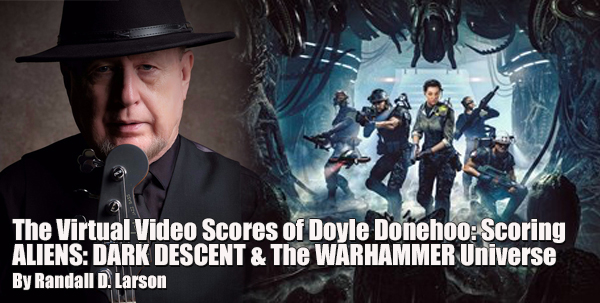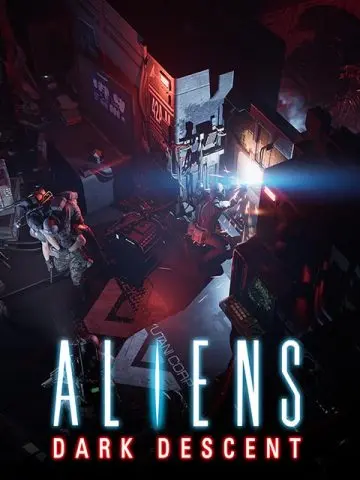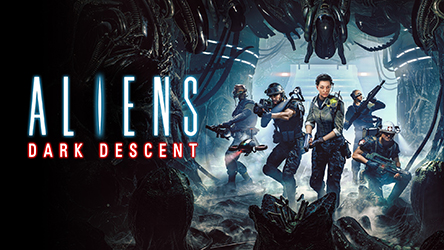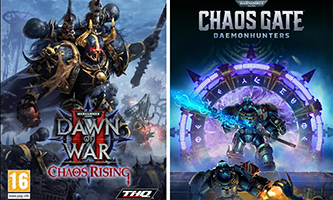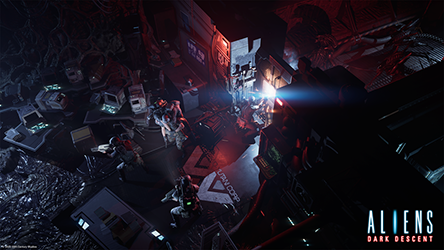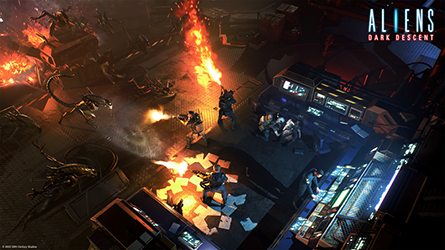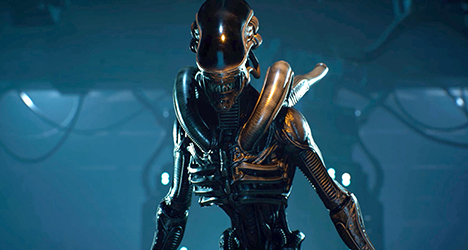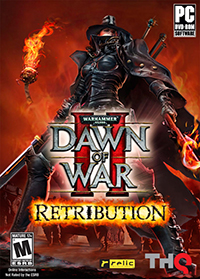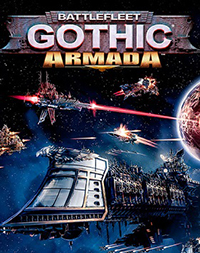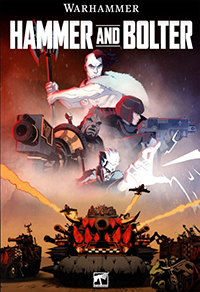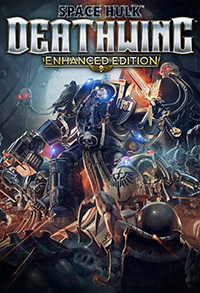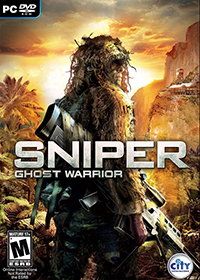
 |
||
|
Soundtrax 2024-3: Special Edition
Feature Interview:
The Virtual Video Scores of Doyle Donehoo:
Scoring ALIENS: DARK DESCENT & The WARHAMMER Universe
Interview by Randall D. Larson
Doyle W. Donehoo is a composer and producer of dramatic music for games and other mixed media. His credits include scoring the games WARHAMMER 40,000: DAWN OF WAR 2, AMERICA’S ARMY, SAVAGE 2, and others. A musician at heart, Doyle has always been on the technical leading edge of music and sound. He is an expert in symphonic virtual orchestral music and mixed hybrid media. His 20 years as a former software engineer and manager makes him uniquely different from other composers of our time, where he intuitively understands what’s going on “under the hood” of his systems. Besides writing and producing music for some of today’s most prestigious video games, Doyle has also lectured at the Game Developer Conference (GDC), NAMM, and many colleges on the computer-based Virtual Orchestra. He has also been praised for his technical articles in various publications such as Music4Games and Virtual Instruments magazine.
Doyle’s most recent video game score is for the recently released ALIENS: DARK DESCENT, a real-time strategy video game developed by Tindalos Interactive in collaboration with Disney’s 20th Century Games and published by Focus Entertainment. Set in the ALIEN universe and taking place 20 years after the events of ALIEN 3, a team of colonial marines must stop a Xenomorph outbreak while gathering resources to repair their Otago spacecraft on the moon base of Lethe. The game was released on June 20, 2023for PlayStation 4, PlayStation 5, Windows, Xbox One, and Xbox Series X/S.
“One of our goals was to stay as accurate as possible to the musical vocabulary set down in the ALIEN movies by Jerry Goldsmith, James Horner, and Elliot Goldenthal. These movies and their scores, which I listened to so many times, meant so much to me as a budding composer who saw (and was freaked out by) the Alien movies in the dome theaters of San Jose. We wanted to capture as much of that unique dread Alien atmosphere as possible. Naturally, we added a more modern approach as well as featuring instruments not available to the above ALIEN(s) composers. When gamers play this game, we want the listeners to be sonically plunged again into the bowls of the Nostromo or the shattered hallways of Colony LV-426. However, in this game, we have some new locations with a similar feel to what we saw in the ALIEN(s) movies. I think the true hardcore fans of the Aliens franchise will be pleased with what we have composed. “- Doyle Donehoo
Q: How did you get started in scoring video games? I believe AMERICA’S ARMY was your first credited game project.
Doyle Donehoo: In those days, I was mostly in bands and doing prog-rock things. I’d been in music most of my entire life. I was mainly playing bass and later on keyboards and then doing all the instruments and recording my own prog-rock-centered albums. Then I started getting interested in movie scores even more, and I started studying it more, and it was around 2000 that I decided to be a full-time composer. I’d reached a point where I quit being in bands once I got to the point where I could do it all myself. The computer revolution and then the MIDI revolution came along, and I could do it all myself, so I invested in virtual instruments. I came from a software engineer background – I’d designed my own music software to record my albums and things. Still, eventually, the industry caught up with me, and my stuff looked pretty poor compared to what was possible with the newer software. And then I was getting into film and game scores, and I decided I wanted to do full-time music because I was coming up with really good results in my studio.
AMERICA’S ARMY was probably one of the very first games I did. There were a couple of others – a game called SNIPER that I did and a few other things that are not of consequence. AMERICA’s ARMY was probably the first high visibility thing that I did, and then I did DAWN OF WAR 2, which was my game changer. After that, life was different!
Q: Regarding ALIENS: DARK DESCENT, the ALIENS franchise has had a long and varied history in films and video games. What brought you into scoring this game?
Doyle Donehoo: I’ve been a long-time fan of the ALIEN franchise. I saw ALIEN in a big movie theater on a giant curved screen, and I was immediately smitten by the music because the first thing you see on ALIEN is this planet and the ship going by, which just totally creeped me out. I’ve always been a fan of science fiction, and this was the first time I felt “Maybe we don’t belong out there!” because it was pretty scary! I went back, saw it numerous times, and got the DVD and Blu-Ray. I collected the program, the picture book, the making-of-book, and of course, the CDs. I wanted to study Jerry Goldsmith’s score! And when ALIENS came out, I was the first in line for that, and I collected the scores and analyzed that too.
Q: With ALIENS: DARK DESCENT, how did you begin to acknowledge its franchise history while making this game score its own element?
Doyle Donehoo: That was a two-prong thing. When you’re a composer, and you’re the first to work on an IP like mine – I think I was the first person who did really extensive scores on WARHAMMER. I was able to create the musical language for WARHAMMER, which was big, orchestral, epic, brassy, and dark sounding, so I established the direction for that game. But when you’re working on an IP like ALIEN or ALIENS… Have you ever seen the first movie of what becomes a franchise, and you love everything about it, and then they do the sequel and the movie and the music’s different, and you’re really disappointed? I didn’t want to disappoint anybody with ALIENS: DARK DESCENT. I wanted to speak the same musical language that Jerry Goldsmith and James Horner had done; not to copy, but to be true to the musical language and feel of things – not the melodies, but the sounds. For example, I went through the first two movie scores, and selected sounds very indicative of the ALIEN environment. There’s something which I call “echo-collegno,” which is the sound of violinists in the orchestra taking their bows and striking the violin with them, and it makes kind of a clacking sound in such a way that when you hear it in the score there’s an echo, and the sound fades away. It’s used a lot in the first two ALIEN scores, where they had echo flutes, echo trumpets, and echo-collegno. So, with various instruments played in certain ways, that’s what contributed to the sound of ALIENS that we liked when we saw the movie.
I’ve had jobs in the past, especially WARHAMMER, where they actually referenced the ALIENS scores for their particular game – for example, the Tyranids in WARHAMMER are very much like the Aliens; they’re kind of bug-like, swarming creatures, in much more vast numbers than we saw with ALIEN. It was the same kind of thing where there’s a lot of sneaking around and flinching at shadows, jump scares, and things like that. I’d gotten the sound together, making my own things in the same style so that it would have that sound to it, and so it wouldn’t be disappointing. However, you’d still feel like you’re in that creepy ALIENS environment, whether you’re sneaking around a spaceship in the air ducts or had some space colony going down hallways; you have your detector going off because there’s movement out there in the distance, that kind of stuff. I wanted to get those feelings so that when people listen to the score, they thought, “This sounds like ALIEN” or “This sounds like it should be ALIENS.” If I’ve immersed the game players into the environment and they think it feels like that ALIEN milieu, then I feel I’ve succeeded in doing my job.
Q: As the gameplay develops, how does one build the music for the myriad dark corners a player will encounter when exploring the game’s avenues?
Doyle Donehoo: I did something unusual in scoring this game. I did it in conjunction with the developers in that some of the things I developed were ten or more minutes long, and that’s because – and this was all pre-planned and everything – I wanted to divide the music into various feelings. Nothing much is going on or sneaking around, and then there’s something going on out there. We can detect the first encounters and then all-out combat because they would come across things in the environment that showed evidence of what they were up against. So, all that stuff was put together in a progression in one track, and you can hear how a lot of that is progressing from one element to the other until it gets to a pivotal element, like fighting the Alien Queen. Those elements were done separately, because they needed a specific treatment and were all in the same key. I developed the very long tracks because it makes it straightforward to edit and pull out things that we needed for various situations, and it will all fit together pretty well because it’s all done in the same key, the same style. You can’t do that with something like a symphony – you just can’t chop things up and put them anywhere – but when you’re working in an environment where there’s a lot of slow, developing things, it’s a lot easier, the way we did it, to have this very long track and just go through, edit, and pluck out what you needed to fit whatever was going on in your environment at specific points.
Q: You’ve scored a number of the WARHAMMER 40,000 game series – how did you start with DAWN OF WAR II, back in 2009, and carry that music through the other iterations of WARHAMMER?
Doyle Donehoo: I went to E3 [trade event for the video game industry] back then, and I saw the demo of DAWN OF WAR, the first game, and I loved it. It was a natural fit for me because it was the kind of music I had in my head and wanted to do. I could instantly imagine the music that went with it – it would be perfect for the big, brassy music that was my favorite thing to do then. They didn’t want a lot of percussions – at that time, there was a lot of percussion with some violins and orchestra over the top of it, but the DAWN OF WAR team wanted to be very orchestral without being super percussive. They wanted the whole orchestra to carry the music. Of course, I still put percussion in there, but it was more orchestral percussion, not the big taiko drums and gangs of toms and other stuff that is often used. I stayed with a few toms here and there, a lot of tympani, and things like that, but not too much. Part of my plan was to make it big and brassy and sound very huge, with a lot of bottom-end strings playing and a lot of dark brass because of the dark nature of the WARHAMMER universe that I was writing for. I wasn’t writing for a picnic in the park – I was writing for this bloody universe where life is cheap, and death and destruction are an everyday occurrence! Since then, I’ve refined it more. I’ve added more subtlety to the scores, but that’s how it began.
Q: Then we have the two BATTLEFLEET GOTHIC: ARMADA scores set in the WARHAMMER universe. How did you create a new score for these games while including the sonic sensibility of WARHAMMER?
Doyle Donehoo: That’s exactly right. I’m still incorporating what I feel to be the WARHAMMER sound that I established with some of the other WARHAMMER games. When it comes to the BATTLEFLEET GOTHIC stuff, I injected more of a maritime influence into it because they had torpedoes and broadsides and things that you mainly associate with battles at sea. That was probably the most significant difference between that and the regular WARHAMMER scores. Also, for every ethnic group that I have to score for, they all have their own themes and approaches – for example, the Eldar, who are in the BATTLEFLEET GOTHIC scores, I do more of an Eldar approach, which I’d already been doing for years. In the DAWN OF WAR stuff, we represented all the races; we had the Orcs, which were very percussive – they allowed me to be percussive on that because they were big and brutish creatures, so there were a lot of tribal-sounding drums, percussion, and even more brass. And with the Eldar, who were a more technological and advanced people, I introduced more synthetic sounds in addition to the orchestral sounds, and so on. In BATTLEFLEET GOTHIC, there were different races in there, too, so there was some interjecting of the flavor of those races in the music as well, but keeping a sort of maritime theme. I did a trailer for WORLD OF BATTLESHIPS, which was definitely a VICTORY AT SEA approach to maritime themes and music. There are characters you have to score for in games, and the idea, if you’re working on WARHAMMER, you’re making it sound like WARHAMMER. Still, you also try to play to the characters that are involved, whether they’re Orcs, Space Marines, or any of the other races that are in WARHAMMER. ?
Q: You’d also scored two episodes of the animated HAMMER AND BOLTER TV miniseries, exploring a multitude of different characters and factions within the WARHAMMER environs. What was this experience like, and how did you find the difference between scoring the video game and the episodic needs of the TV series?
Doyle Donehoo: I’d scored video projects throughout the WARHAMMER games. There’s been video stuff that I’ve had to score, and numerous ones for DAWN OF WAR II and others. A Pixar guy was doing a private project, and I worked on that. My studio’s set up for that, too, so I’m not a stranger to writing to picture. Truth be known, I think writing to picture is easier than writing for video games. Video games can get obscenely complex, especially for interactive stuff. There are some top-shelf, triple-A games that have done serious work with gangs of people and composers and audio guys to interact with scores, and it’s not easy to do. The things that I’ve always been involved in have not been as large scale as those triple-A projects, like STAR WARS BATTLEFRONT and things like that – but the goals are pretty much set forward and easier to hit. You’re still making music for changing environments, and you have to compensate for those environments and how to write for them. That’s one of the things I was talking about previously about the very long tracks, where they could pluck things out of it, edit it, and put it together, and it will still sound cohesive. Plus, it’s still essentially the same thing. If it goes from sneaking around to discovery to storytelling, it’s all there in the music already, so it’s easy to pick that up and plug it in – and maybe do some edits to fit the time.
It’s still different than doing an episode, but I’ve found it a lot of fun; it’s refreshing because it’s more straightforward than doing video games because it’s all there – it’s all linear. Usually, as a composer, you get it at a state where it’s time locked, so things aren’t going to change. You can score things so that the music hits specific dramatic points. You plan for that. It does get a little ugly when they decide to change things around at the last minute and make Swiss cheese out of their video, and you have to rearrange things to fit that, but that’s like working on a word processor – you delete and copy and erase and close things up. Instead of a word processor, I have a music processor! In general, it’s often all very linear, and you know where all the points are; you’ve discussed them ahead of time in video conferences. You say, “Well, I want this to happen at this point, and I want that to happen at that point, and have this kind of music at this point; oh, here’s a very dramatic section, I want this to sound kind of sad with longing, whereas this over here is pensive, or scary…” All that goes into planning for it, but the idea is all there, right in front of you, all timed out. The imagery and everything are there; you get a sense of what should happen at certain points because it’s expected. All you have to do is score for it, and video episodes like this tell you what to do. So, it’s a lot of fun for me; I do what the video tells me to do and what my creativity tells me to do, and it pretty much works out! ?
Q: Another project was SPACE HULK: DEATHWING. What can you tell me about your score for this project?
Doyle Donehoo: That was a bang-bang, shoot-shoot kind of thing, with constant action. There wasn’t much music involved in that, not as much as in some projects, but enough. The approach was straightforward Space Marine WARHAMMER action music. There were very few times when you were just sneaking around the Space Hulk, and I did have music for that, but mostly it was for combat.
Q: Then you’ve scored SNIPER: GHOST WARRIOR. How would you describe its musical elements?
Doyle Donehoo: That was more like ALIEN, a lot of very subtle things and uneasy creeping. Since I owned that particular score, I put it out for sync licensing, and it’s shown up on a lot of action TV shows when they wanted real tense moments. There were also sections of that music where it was just a lot of slinking around because snipers spend a lot of time skulking, hiding, and getting into position for that ten minutes of intensity when they finally find their target. Q: With these game scores, are you using live ensembles, or is it electronic elements or a mix thereof? Doyle Donehoo: It’s all virtual orchestration, which I’ve been doing before 2000. When virtual orchestrations first started up, they didn’t sound as good as it does today, but it was still pretty good, and one of the things that was happening in the movie industry and the game industry was that producers wanted to hear what the music was going to sound like. You couldn’t just sit at the piano and play things and say, “For this section, it’ll be like this, and for this other section, it’ll be more melodic like this!” That wasn’t working anymore; producers and directors wanted to hear what it would sound like. I had an advantage, coming from a software engineering background; I’d built and designed computers and wrote a lot of software, so I had a real leg-up on things. I had the natural advantage of being able to say, “Here’s what it’s going to sound like,” and I got some really good [virtual] instruments together that sounded pretty good. I still think that the DAWN OF WAR soundtrack holds up pretty well as an album and as something to listen to. But today, we have instruments that are vastly improved over ten or twenty years ago, and we have so many tools in our toolbox for doing things. I think I have over four terabytes of instruments, more than I can use. For every one instrument out of a library, there are ten others I didn’t use! So, I do a lot of cherry-picking, getting things that sound the best and most realistic. Most TV stuff is all done virtually, except for some shows with bigger budgets – they’ll bring in orchestras, or at least players, to do certain parts. But there’s a lot of stuff out there, environments I need to compete with and some I don’t need to. What I produce is very competitive and sounds right; my primary thing is making music.
__________________________________________________________________________________________
Randall D. Larson was for many years publisher of CinemaScore: The Film Music Journal, senior editor for Soundtrack Magazine, and a film music columnist for Cinefantastique magazine. A specialist on horror film music, he is the author of Musique Fantastique: 100+ Years of Fantasy, Science Fiction & Horror Film Music, and Music from the House of Hammer. He currently writes articles on film music and sf/horror cinema, and has written liner notes on more than 300 soundtrack CDs. He can be contacted via https://musiquefantastique.com/ or follow Musique Fantastique on Facebook. Follow Randall on Twitter at https://twitter.com/randalldlarson and https://twitter.com/MusiqueFantast1
